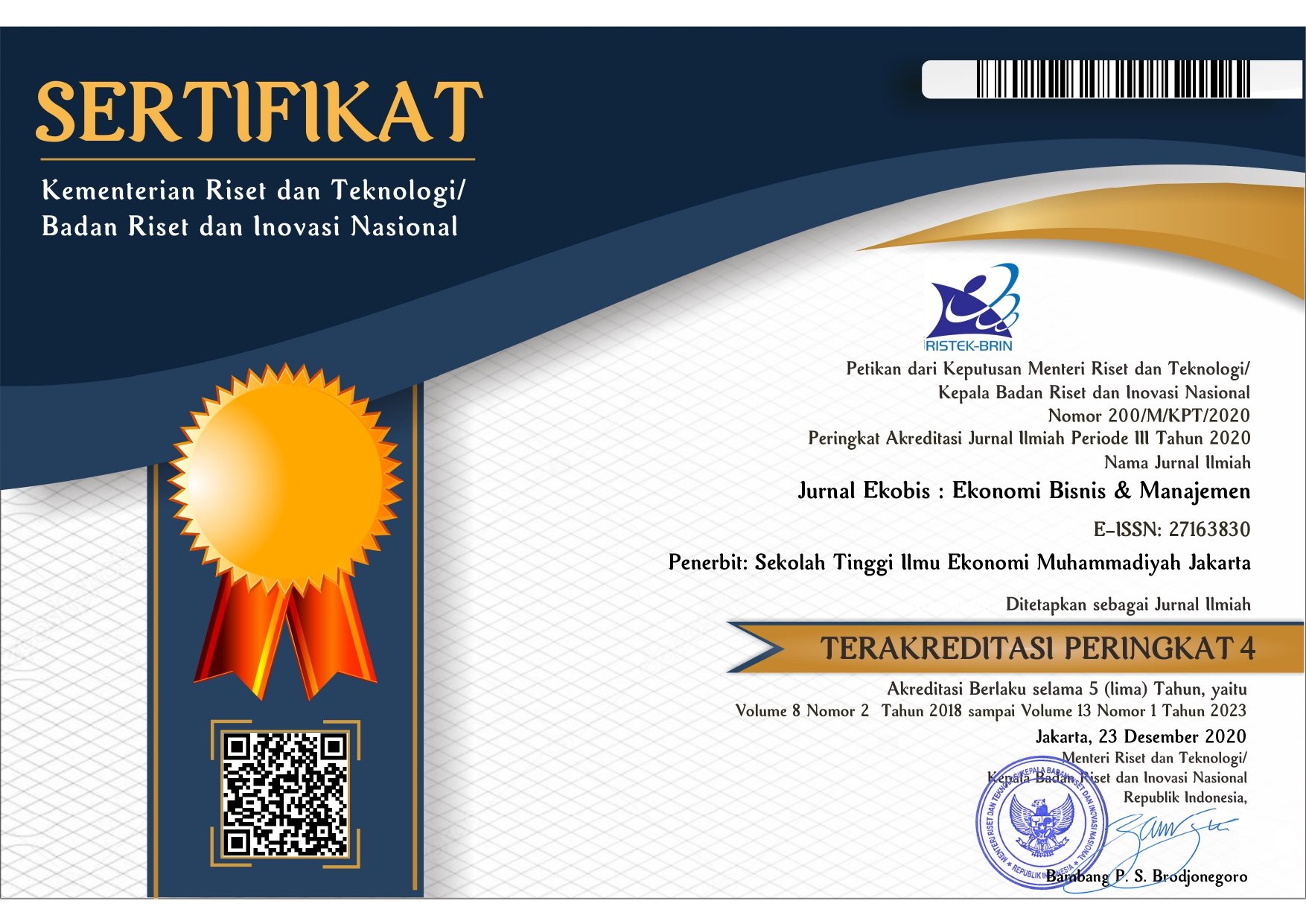ANALISIS STRATEGI PEMASARAN GO-JEK INDONESIA PASCA KELUARNYA UBER DARI PASAR TRANSPORTASI DARING INDONESIA
DOI:
https://doi.org/10.37932/j.e.v8i2.39Keywords:
Marketing strategy, Go-Jek, PromotionAbstract
This study aims to analyze the empirical evidence of Go-Jek Indonesia's marketing strategy after the exit of the market from the Indonesian online transportation market. The development of the online motorcycle taxi market is very dynamic, in 2018 Uber left Indonesia and was acquired by Grab. After this event, Go-jek needs a revaluation of its marketing strategy to capture the opportunity to move consumers from Uber and strengthen its position as the ruler of the online motorcycle taxi market in Indonesia. The main finding of this research is that Go-jek is expected to conduct revaluation on the segmentation and positioning of the Go-jek brand in the market. The expansion of segmentation is needed to capture first-class consumer opportunities and increase brand awareness. Go-jek can use the promo code marketing strategy in its application to increase the opportunity to purchase services again. The development of features that accept credit cards as payments can also be an effective marketing strategy to capture Uber consumers. Research recommends Go-jek to develop credit card features, Go-jek Premium with high-capacity vehicles, promotion at events with top-class economic segmentation and expansion of marketing strategies in the aggregate.References
Arianis, C., Maharani, M., & Tresna, P. (2017). Comparison of User Experience On Go-Jek And Grab Mobile Apps (Study on PT. Go-Jek And PT. Grab Indonesia Consumer in Dki Jakarta). Jurnal AdBispreneur Vol 2 (2), 163-173. Farida, I., & Tarmizi, A. (2016). Analisis Pengaruh Bauran Pemasaran 7P Terhadap Kepuasan Pelanggan Pengguna Gojek Online. Jurnal Riset Manajemen dan Bisnis Vol 1 (1), 31-40.
Gunawan, S. (2017). Persepsi Konsumen Atas Layanan Grab Car Di Surabaya. Jurnal Agora Vol 5 (3). Jakarta post. (2018, Februari 20). http:// www.thejakartapost.com/life/2018/02/20/ indonesias-most-popular-ride-hailing-app- survey.html. Dipetik Mei 4, 2018, dari Jakarta Post: http://www.thejakartapost.com/life/2018/ 02/20/indonesias-most-popular-ride-hailing- app-survey.html
Jakartapost. (2018, Maret 26). Uber pulls out of Southeast Asia, selling operation to Grab. Dipetik Mei 4, 2018, dari Jakartapost Website: http://www.thejakartapost.com/news/2018/03/ 26/uberpulls-out-of-southeast-asia-selling- operation-to-grab.html
Jennie M, X. (2015). Generasi Milenial: Berkat atau Kutuk? Forum Manajemen Vol 3.
Kotler, P., & Keller, K. (2012). Manajemen pemasaran dan Perusahaan. Jakarta: Indeks Kelompok Gramedia.
Leksono, R., & Herwin. (2017). Pengaruh Harga Dan Promosi Grab Terhadap Brand Image Yang Mempengaruhi Keputusan Pembelian Konsumen Pengguna Transportasi Berbasis Online. Jurnal Riset Manajemen dan Bisnis UNIAT Vol 2 (3), 381-390.
Lupiyoadi, R. (2013). Manajemen Pemasaran Jasa. Jakarta: Salemba Empat.
Magdalena, E. (2016). Sikap Masyarakat Jakarta Pengguna Aplikasi Grab Terhadap Brand Baru Grab. Jurnal e-Komunikasi Vol 4 (1).
Mahayuni, P., Purnawan, N., & Cahyani, D. (2016). Strategi Komunikasi Pemasaran Terpadu Pt. Go-Jek Indonesia Branch Bali dalam Membentuk Brand Awareness. e-Journal Medium Vol 1 (1).
Sari, E. (2015). Wilson-Lowi Matrix and Go-Jek Transportation: Analysis Of Political Competition As Nonmarket Strategy. Media Mahardika Vol 13 (3).
Setyaji, D., & Ngatno. (2016). Pengaruh Kualitas Pelayanan dan Kepuasan Konsumen terhadap Loyalitas Pelanggan (Studi Kasus pada Pelanggan Go-Jek di Semarang). Jurnal Administrasi Bisnis Vol 5 (4).
Simanjuntak, E. (2018). Peran Brand Image Memediasi Pengaruh Promosi Dan Harga Terhadap Loyalitas Konsumen Uber Taksi Di Denpasar. e-Jurnal Manajemen UNUD Vol 7 (2), 874904.
Sumangunsong, J., Aprianingsih, A., & Magdalena, I. (2017). Understanding the Rejection Phenomena of Technology-Based Transportation New Entrant: A Case Study of Go-Jek in Bandung. Journal of Engineering and Applied Sciences Vol 12 (17, 43674373.
Tjiptono, F. (2014). Strategi Pemasaran.Yogyakarta: Andi Ofset.
Utari, N. P., & Sharif, O. (2016). Analysis of Service Quality of Go-Jek Indonesia in Jabodetabek, Bandung, Surabaya, Bali, and Makassar . IOSR Journal of Business and Management Vol 18 (4), 93-98.
Utomo, H. (2017). Perbandingan Usabilitas Aplikasi Taxi Online Android (Grab-car dan Uber) Menggunakan Unified Theory of Acceptance and Use of Technology (UTAUT). Jurnal Pengembangan Teknologi dan Informasi dan Ilmu Komputer Vol 1 (12), 17081717.
Vidyastuti, H. (2016). Kinerja Bauran Pemasaran Jasa Transportasi Roda Dua Dalam Meningkatkan Keunggulan Bersaing Serta Pengaruhnya Pada Loyalitas Pelanggan ( Survey Pada Pelanggan Go-jek dan Ojek Pangkalan di Kota Bandung ). Jurnal Ekonomi dan Menajemen STIE Dharma Negara Vol 1 (1).
Wahid, U., & Puspita, A. (2017). Upaya Pening- katkan Brand Awareness PT. Go-Jek Indonesia Melalui Aktivitas Marketing Public Relations. Jurnal Komunikasi Vol 9 (1), 31-43.
Downloads
Published
How to Cite
Issue
Section
License
Copyright Notice
Copyright
Authors retain copyright and grant the journal right of first publication with the work simultaneously licensed under a Creative Commons Attribution-ShareAlike 4.0 International License that allows others to share the work with an acknowledgment of initial publication in this journal.
Authors are permitted and encouraged to post their work online (e.g., in institutional repositories or on their website) before and during the submission process, as it can lead to productive exchanges and earlier and greater citation of published work (See The Effect of Open Access).
License
You are free to:
- Share — copy and redistribute the material in any medium or format
- Adapt — remix, transform, and build upon the material
- for any purpose, even commercially.
Under the following terms:
-
Attribution — You must give appropriate credit, provide a link to the license, and indicate if changes were made. You may do so in any reasonable manner, but not in any way that suggests the licensor endorses you or your use.
-
ShareAlike — If you remix, transform, or build upon the material, you must distribute your contributions under the same license as the original.
- No additional restrictions — You may not apply legal terms or technological measures that legally restrict others from doing anything the license permits.
Jurnal Ekobis: Ekonomi Bisnis & Majemen is licenced under Creative Commons Attribution-ShareAlike 4.0 International (CC BY-SA 4.0).
Privacy Statement
The names and email addresses entered in this journal site will be used exclusively for the stated purposes of this journal and will not be made available for any other purpose or to any other party.



